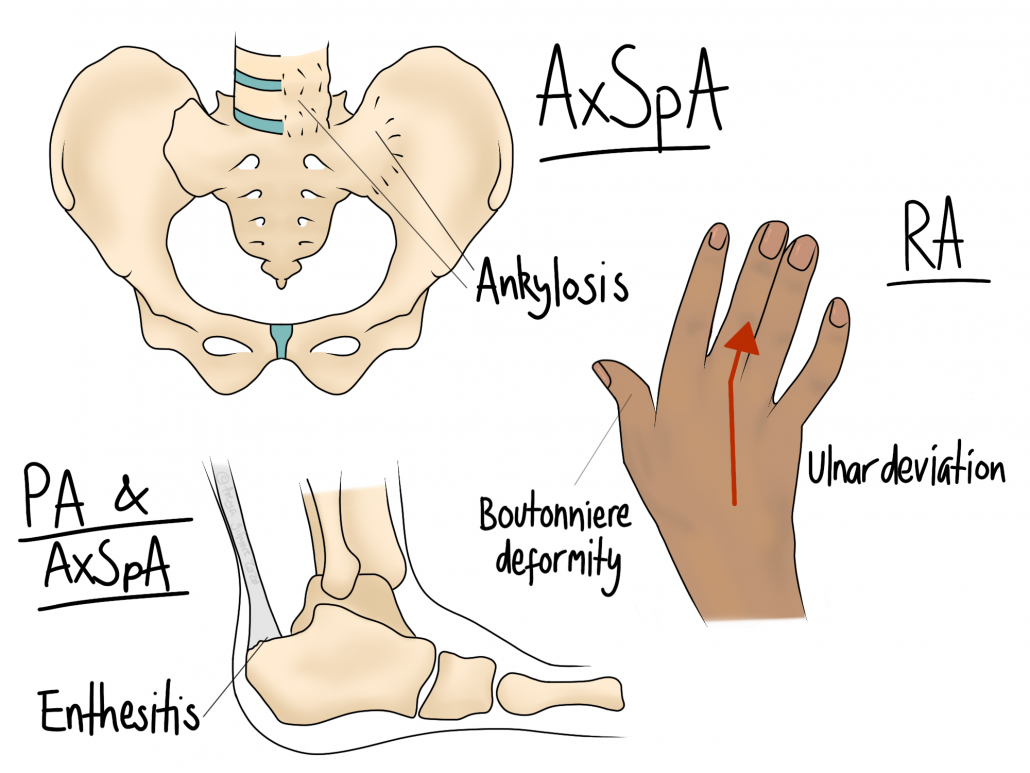Rheumatic conditions cannot be cured by osteopathy, but they may respond well with regards to pain.
Osteopathy and Rheumatic Conditions
Osteopaths learn about these conditions during training, as we need to be able to identify when something is out of our remit.

Rheumatoid Arthritis
Rheumatoid Arthritis (RA) is different to osteoarthritis (more on that below). It is an autoimmune condition in which the small joints of the hands and feet become inflamed. During these inflammatory episodes, the body attacks its own cells in the joint surface. This causes pain, stiffness, restriction, and deformity. The image above shows two ways in which deformity can affect the hands. The joints of the fingers can become swollen (Boutinniere deformity), and the hand can deviate away from the thumb. A third example, not pictured, is a swan-neck deformity, in which the last joint in the finger hyper-extends, and the next one remains slightly flexed.
These deformities are late stage signs of RA. There are medicines readily available to help slow the progress of RA, so with diagnosis and appropriate referral, outcomes can be good.
RA patients experience flares of their symptoms during the inflammatory stages. These are generally the most painful periods, although we expect everyday pain to worsen as the joints become more damaged over time. Pain in the long and short term can both benefit from osteopathic treatment and the prescription of exercises. The best results will come from a combined approach of medication and exercise.
Ankylosing Spondylitis
Chronic lower back pain with an inflammatory pattern needs to be assessed for the possibility of Ankylosing Spondylitis (AS). Signs of inflammatory back pain include:
- Morning stiffness lasting 30 minutes or longer
- Good response to NSAIDs
- Symptoms aggravated by rest
- Symptoms relieved by gentle exercises
AS is illustrated above. During periods of inflammation, the joints in the spine and pelvis are damaged. After a flare, the body attempts to heal itself, but instead of healing the joint surfaces, it lays bone over the whole joint. This eventually causes fusion of these joints, along with pain and stiffness. It takes an average of 8 years for someone with AS to get a diagnosis, as it is so often mistaken for typical lower back pain. Your osteopath is in a good position to spot the signs of AS and help you get a diagnosis from a rhuematologist. Gentle treatment can also help with the pain.
The fusion process affects the joints in the upper back too. For this reason, it is even more important that we spot AS as soon as possible. Manipulation (clicking) of the upper back in people with AS is inappropriate as it may cause fracture of the new bone.
Osteoarthritis (truly rheumatic?)
Although osteoarthritis (OA) is sometimes considered a rheumatic condition, it is quite different to the other conditions above. Rather than being autoimmune, it is a mechanical process of “wear and tear”. OA responds well to osteopathic treatment, and with good management, the process can be slowed or even stopped. In the early stages, resuming proper movement can encourage the cartilage to heal to some extent, potentially reversing some of the damage. You can read more about OA here.
You can book an appointment online here if you need help managing your rheumatic pain.

